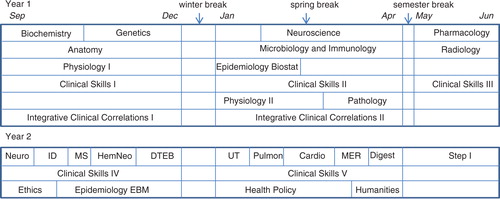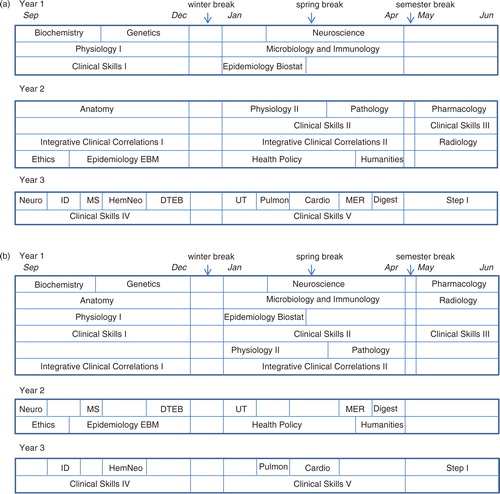Figures & data
Fig. 1. Regular preclinical curriculum. Year 1 consists of two semesters (fall and spring) of 16 weeks followed by a 7-week summer semester. Some courses are full semester while others are shorter. Biochemistry, genetics, epidemiology/biostatistics, and pathology are each 8 weeks long; physiology II is 9 weeks, and neuroscience is 12 weeks. Year 2 consists of two semesters (fall and spring) of 16 weeks. Year 2 courses vary in length, with the problem-based learning (PBL) courses running sequentially to each other, and parallel to clinical skills and courses in ethics (8 weeks), epidemiology/evidence-based medicine (8 weeks), health policy (12 weeks), and humanities (4 weeks). PBL domains: neuroscience (neuro, 3 weeks); infectious disease/immunology (ID, 3 weeks); musculo-skeletal (MS, 2 weeks); hematology/neoplasia (HemNeo, 4 weeks); disorders of thought, emotion, and behavior (DTEB, 4 weeks); urinary tract (UT, 3 weeks); pulmonary (3 weeks); cardiology (4 weeks); metabolic, endocrine, reproductive (MER, 3 weeks); and digestive (Dig, 3 weeks).

Fig. 2. (a) Sample year 1 extended curriculum. A student extending in early in the first year can spread out the year 1 courses over 2 years, with the following restrictions: either physiology I or anatomy must be taken in the first year; physiology I is a prerequisite for physiology II; biochemistry is a prerequisite for microbiology/immunology; microbiology/immunology and physiology II must be taken prior to or concurrently with pathology; and pharmacology must be taken the summer immediately prior to the first PBL course (neurology). In the second year, a student may take one or more of four-year 2 courses (ethics, epidemiology/EBM, health policy, and humanities). (b) Sample year 2 extended curriculum. A student extending in year 2 (after completing year 1) can spread out the year 2 courses over 2 years, with the following restrictions: the first PBL domain, neuroscience, must be taken before all other; pulmonary and cardiology should be taken in the same year; and clinical skills IV and V must be taken in the year immediately prior to Step I.

Table 1 Graduates’ perceptions of the extended curriculum programa
Table 2 A comparison of academic performance and career outcomes for extended and non-extended graduates (based on matriculants from 1991 to 2003)
